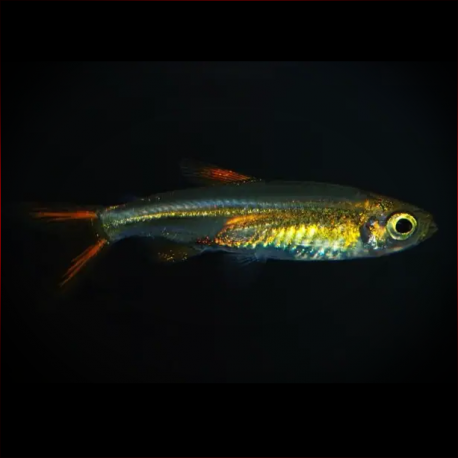More info
Datasheet
| Minimum Tank Size | 60 litres / 15.85 US gallons |
| Maximum Size | 3.1cm / 1.22inches |
| Temperature | 20°C / 68.00°F - 26°C / 78.80°F |
| Hardness | 1.01dgH / 18ppm - 8.01dgH / 143ppm |
| pH | 5.0-7.0 |
Behaviour:
The Ladigesia Roloffi, commonly known as the Jelly Bean Tetra, is generally peaceful with other species but is not the ideal community fish due to its small size and somewhat specialized requirements. Tankmates such as Lepidarchus adonis or Neolebias ansorgii, along with similarly-sized quiet species like smaller cyprinids, anabantoids, callichthyids, and loricariids, can make suitable companions. It can also cohabit with smaller cichlid species, but thorough research before purchase is advised. Keeping a group of at least 8-10 specimens is recommended as these tetras are gregarious, leading to less shyness and more interesting behavior in larger groups.
Feeding and Diet:
In nature, Ladigesia Roloffi is likely a micropredator, feeding on tiny invertebrates and zooplankton. In the aquarium, they readily accept appropriately-sized dried foods but should also be offered daily meals of small live and frozen fare such as Artemia nauplii, Daphnia, Moina, and grindal worms to ensure a balanced diet.
Reproduction & Dimorphism:
Breeding Ladigesia Roloffi in aquariums is not common but possible with specific conditions. Soft, acidic water is essential for successful breeding. When breeding, using a layer of peat topped with a mesh or grille to prevent adults from eating the eggs, and providing abundant vegetation is recommended. Males display slightly extended anterior anal-fin rays, while gravid females may appear rounder-bodied. Fry are sensitive to water chemistry fluctuations and require meticulous care during the initial weeks of life.
Habitat and Distribution:
Ladigesia Roloffi's distribution remains unclear, with confirmed sightings only at the type locality 'Kasewe Forest, Sierra Leone,' primarily in the upper Gbangbaia river basin. The species is also recorded in the Du river drainage in the Firestone rubber plantation near Harbel, Liberia. The IUCN assesses Ladigesia Roloffi as 'Endangered.' In Sierra Leone, where this species is found, the climate is hot and wet, with rivers characterized by warm, soft, and acidic water.
Aquarium Setup:
To mimic their natural habitat, Ladigesia Roloffi thrives in a well-structured aquarium with a sandy substrate, driftwood roots, and branches. The addition of dried leaf litter provides natural cover, microbe colonies, and a secondary food source for fry. Dim lighting, aquatic plant species like Microsorum and Cryptocoryne spp., and floating vegetation such as Ceratopteris spp. are recommended. Maintaining acidic and soft water conditions is crucial for the well-being of these tetras. Regular water quality checks are essential due to their sensitivity to fluctuations in organic waste levels.

